If you were to ask a room full of carpenters, welders, masons, and assorted craftsmen and DIY’ers to list their top 10 favor power tools, you’re going to get a large list of tools. However, I bet each of those lists would contain the angle grinder. The number of different angle grinder uses is staggering, which makes it a very valuable tool. However, before you jump right in using your angle grinder, we should cover a few angle grinder safety tips
In this article, We’ll discuss some safety tips and best work practices that need to be followed to safely enjoy everything these awesome tools have to offer. Then we can look at some of the accessories and the angle grinder uses that make them so popular.
In this article, we will be providing you with a few links to some products for pricing and informational purposes. We are required to let you know some of these links are “affiliate links”. This means if you click on a link and make a purchase, we could make a small commission, at no extra cost to you. This helps offset the cost of maintaining our website. Now, let’s get started.
Angle Grinder Safety
Table of Contents
Along with being one of the best, most useful tools in any craftsman’s workshop the angle grinder will also rank right up there with being one of the more dangerous tools too! That means following the manufacturer’s recommendations and using your personal protective equipment (PPE) is a must.
I’m not trying to scare anyone off, but it is essential to protect yourself when using any power tool or piece of equipment. I have written an entire article on the importance of wearing PPE whenever doing any kind of home repairs. I hope you’ll consider reading it to get more ideas on protecting yourself when doing home repair projects.
Angle Grinder PPE
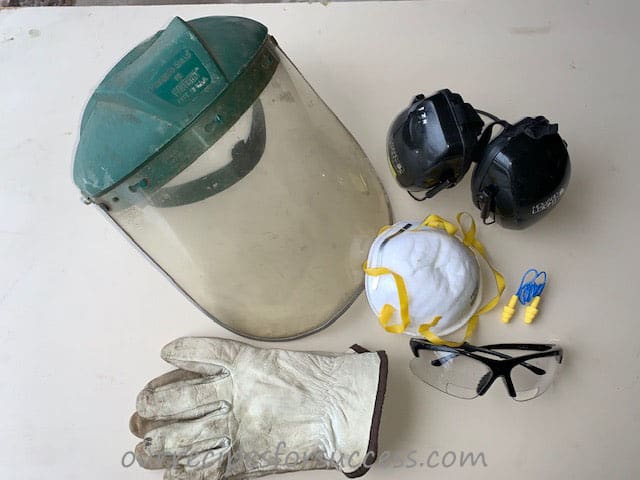
Below is a list of the basic PPE you should use anytime you are using an angle grinder. No matter what type of material you’re working with.
Angle Grinder Safe Work Practices
Along with wearing the proper PPE, there are several other safe work practices that can help prevent injuries. By combining as many of these safety-related items you increase your chance of completing your projects successfully and without injury. Let’s look at a few more ways of making all your angle grinder uses safer.
Treat Your Angle Grinder With Care
I chose to start with this item because neglect and misuse of an angle grinder can lead to a few issues. You never want to throw your grinder around or handle it roughly. Doing this can shorten the life of your grinder, but more importantly, it can damage the grinding wheel or cutting blade on the grinder.
Angle grinders spin in the neighborhood of 10,000 RPMs. If a grinding wheel is damaged from mishandling or misuse it can break apart while in use. These wheels will fly apart in many pieces and will be traveling at a very high velocity. They can easily fly 30, 40 or more feet and cause serious injury.
Aim The Debris From An Angle Grinder To A Safe Area
As discussed earlier, grinders can produce a lot of flying debris. Never aim that debris at yourself or others. It can significantly increase the chances of getting debris in your eyes. It also puts you in the direct line of fire should a grinding disc fly apart. You should reposition your body, the angle grinder, or the piece to make sure the debris is aimed in a safe direction.
Always Use The Angle Grinder Guard
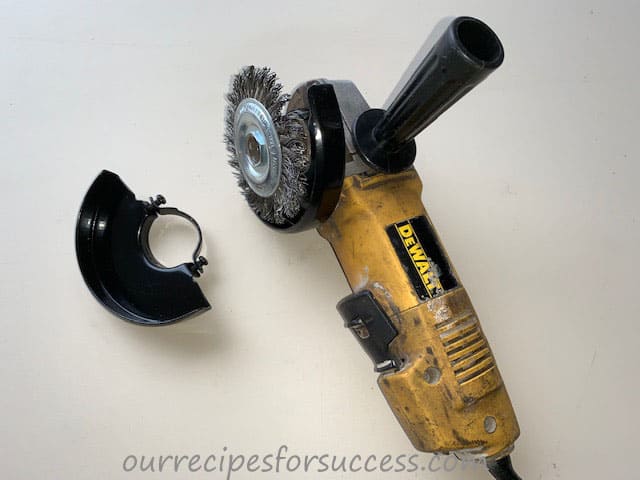
I am fairly certain any angle grinders purchased today will come with a guard. Use it! Guards can protect you from flying debris, failed grinding discs, and help prevent your hand from slipping and coming in contact with the grinding disc or other attachments.
If you find a working angle grinder at a garage sale without a guard, you can buy guards that will fit most grinders. I did that with my Dewalt grinder and it has been a great addition to my workshop.
Use The Angle Grinder Side Handle
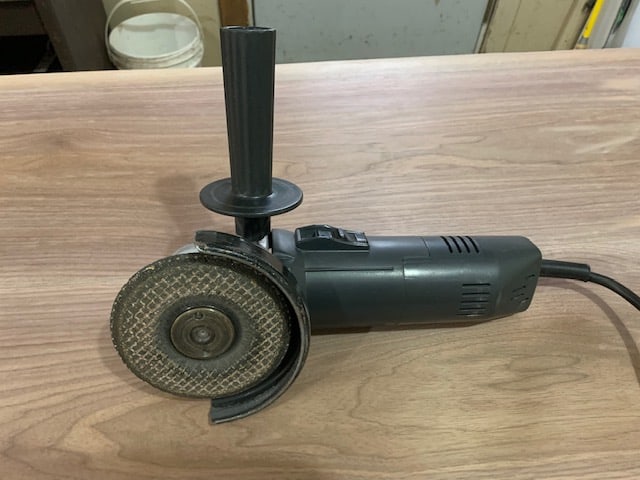
Another attachment most angle grinders come with it the side hand. It screws into the body of the grinder and sticks out at a 90° angle from the grinder body. This handle gives you a second point of contact to securely hold the grinder while it is in use. I highly recommend using the side handle whenever you use your angle grinder.
Be Aware Of Angle Grinder Kickback
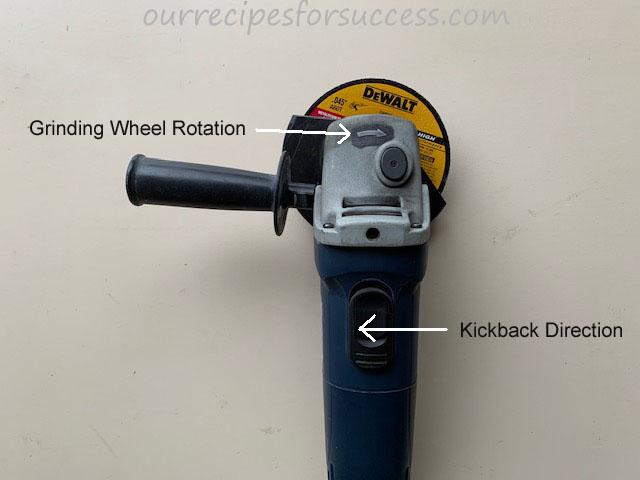
If there are any chainsaw owners out there, then you probably know what “kickback” is. The same thing can happen when running an angle grinder. When a grinding wheel is spinning at 10,000rpm’s and comes in contact with the material you’re working on the grinder and your hands will try to move in the opposite direction. Most of the time being aware of this and securely holding your grinder is all you need to do to control this.
In some cases when using attachments like wire buffing wheel and cutting blades with teeth, they can grab the material you’re working on and this movement in the opposite direction can be quick and quite violent! This is kickback! Understanding kickback and securely holding your angle grinder is your first line of defense against it. Always use the side handle, covered above, when using these types of angle grinder attachments.
Secure Your Work
Any material you are working on should be securely held using a vise or some sort of clamp. As discussed above, angle grinders have the potential to grab the work and throw it if not securely held. Never hold the material in your hand while grinding. Grinders can make sharp edges and cause the materials to heat up. This greatly increases the chance of cuts, burns, and other serious injuries.
Clear Your Work Area
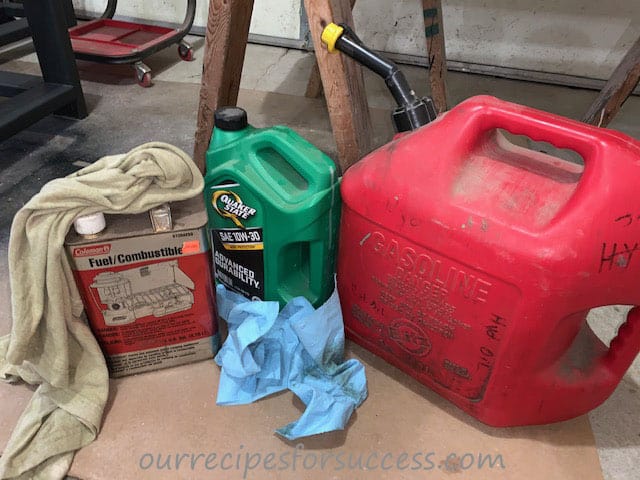
Before you begin using your angle grinder make sure the surrounding area is clear. Make sure there are no people, children, or pets in the area that could be hit by flying debris. Remember, anyone else working in the area should have the proper PPE as well.
You should also clear the area of any flammable or combustible materials. Especially when grinding metal. The shower of flying sparks is capable of causing a fire. After grinding monitor the area for at least 1/2 hour to make sure there is no sign of smoke in smoldering rags or other combustible material.
No Loose Clothing
We just discussed the importance of wearing proper clothing above, but you need to take this one step further. You should never wear any loose clothing while running an angle grinder. This includes things like long shirttails hanging out and nail aprons.
If this clothing comes in contact with the spinning angle grinder attachment, it can become entangled in the attachment. This is especially hazardous when using attachments like wire wheels and some of the wood cutting blades. If this happens, the grinder can be pulled into your body in a split second causing serious injuries!
I want to thank Glen for those words of wisdom some 37 years ago when I was just getting introduced to using grinders. It’s something I’ve never forgotten!
Use Ground Fault Equipment
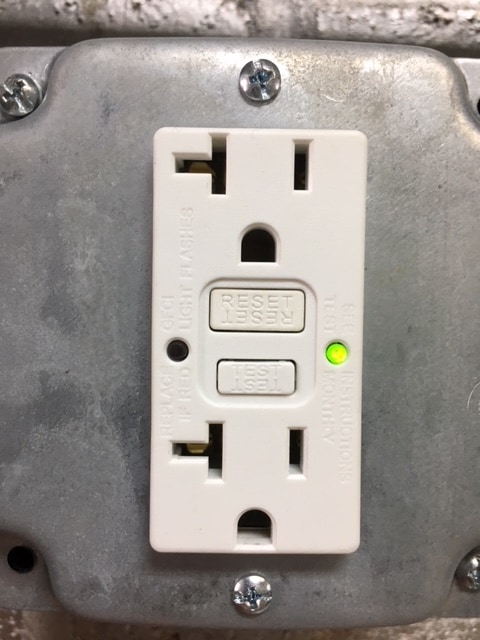
Sometimes when working with masonry products a lot of dust can be generated by the cutting and grinding process. In order to help keep the dust to a minimum, it’s ok to occasionally spray a small amount of water on the material. This also helps keep the blades cooler, which makes them last longer as well. However, as we all know, water and electricity don’t work well together. That’s why you need to take extra precautions when working with any electrical power tools in damp or wet locations.
Be sure to use a ground fault circuit interrupting (GFCI) outlet to power your electrical tools. They are designed to protect you from electrical shock. If a GFCI outlet isn’t available, there are GFCI extension cords and pigtail that can be purchased. They’re a great device when working in damp locations with any power tool.
My Favorite Angle Grinder Uses
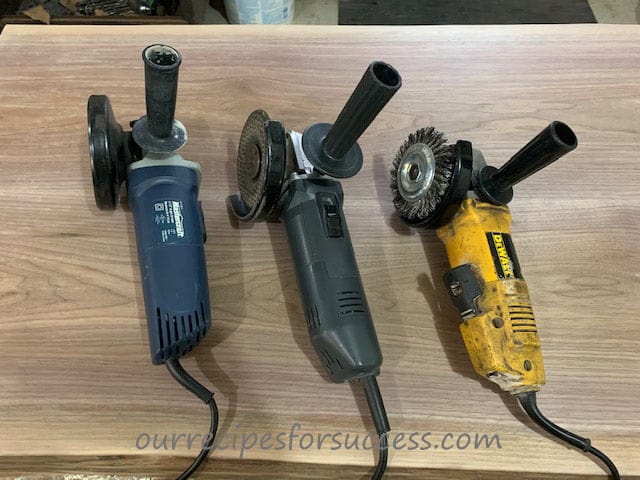
Angle grinders have so many potential uses there is no way I could possibly cover them all. Truthfully, many of the options are tasks or hobbies I have never tried… yet. But it’s nice to know there is a tool out there to help get the job done.
Instead, I am going to share with you some of my favorite angle grinder uses and how they have helped me. Sure I will mention some of the other accessories and provide you with some links for further information and pricing, but my goal is to share some of the practical uses I’ve found for the angle grinder.
I tip for new angle grinder owners is to know what the arbor size for your grinder is. Some accessory wheels will thread directly onto the arbor and they do come in different sizes. The owner’s manual should have that information.
I prefer an angle grinder with the 5/8″ x 11 arbor size. In the US I believe it is pretty much the standard anymore. They are bigger than some and I like that when using some of the more aggressive angle grinder blade and wheel options available.
I have a Skil angle grinder and a Dewalt angle grinder, very similar to the grinders in these links, that I’ve had for many years without any troubles. Whatever brand you choose I believe they will last the average homeowner many years if properly used and cared for.
Angle Grinder Uses For Metal
For first time visitors to our website you should know I am a “hobby welder”. I take on all sorts of welding projects and minor repairs around the house. Here’s a link to a few of my welding projects, with more to come in the future.
For anyone interested in welding a grinder is an absolute must-have tool. They can be used for cleaning, cutting, fitting, and smoothing metal before and after welding. I actually have 3 angle grinders I use all the time when working on a welding project.
One grinder is equipped with a thin cutting wheel, the second with a standard grinding wheel, and the third with a wire buffing wheel. With any welding project, you can expect to use all three of these grinders multiple times. Having the three grinders is a huge time saver, not having to swap wheels, and helps ensure a quality finished product.
Here are a few of my go-to uses for the angle grinder when working with metal.
Cutting Metal
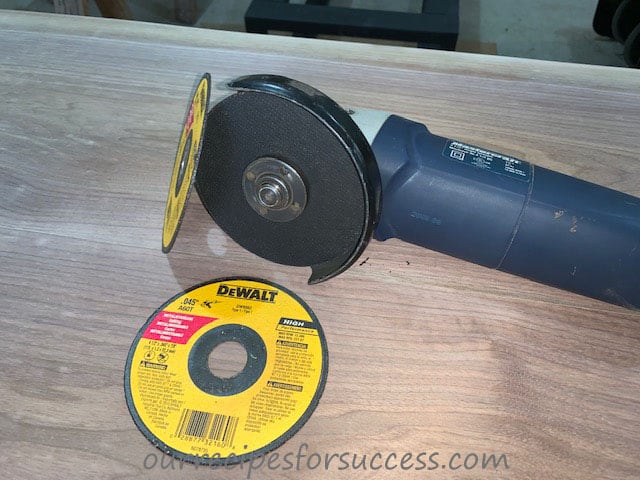
The cut-off wheel is perfect for making a quick cut on smaller pieces of metal. Whether it’s a piece of 1” angle iron or a piece of threaded rod (all-thread). A cut-off wheel can cut through this material in seconds. On larger, heavier pieces of steel, it may not replace a bandsaw or a chop saw, equipped with a cutting wheel, but it certainly has earned its place in my workshop.
Grinding Metal
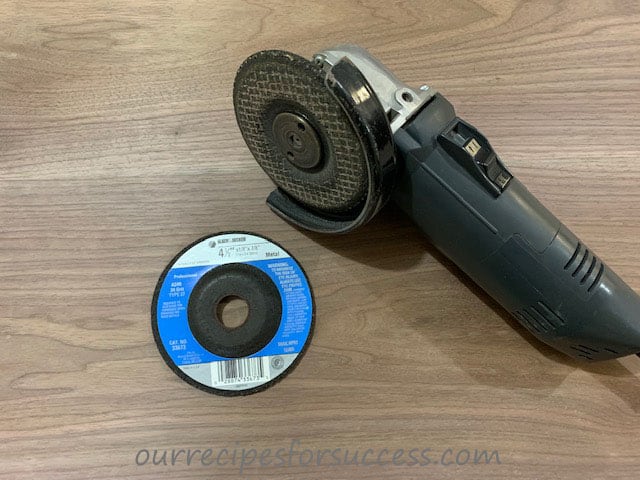
The abrasive grinding wheel is made for grinding, smoothing, and can be used for shaping metal. As mentioned above, it’s a must-have for preparing two pieces of metal to be welded together. They are ideal for removing sharp edges or rounding of a pointed end on any piece of metal.
On the flip side, they are good for sharpening your lawnmower blades, shovels, or other gardening tools. It’s such a versatile tool.
Buffing Metal
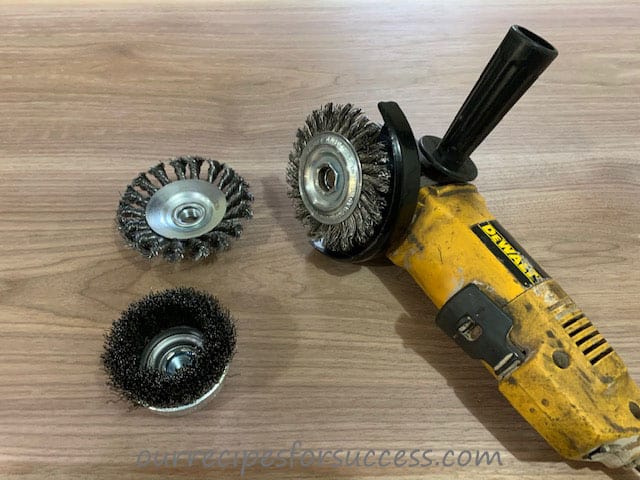
When I say “buffing” metal I am speaking of removing rust or some other wanted scale from the surface. There are actually a couple of different types of buffing wheel made to do this, but they do it in two different ways.
The wire buffing wheel is much like a wire bristled brush, the wire buffing wheel is made with wire bristles. They are great for cleaning rust and scale off the surface of the metal. The wire wheel is great from removing welding slag between welds. This helps ensure a quality weld.
I also use the wire buffing wheel for cleaning the underside of my lawnmower deck in the fall before putting it away for the winter. It cleans all the material off the metal without doing any damage to the metal.
In our article on making a mower deck welding repair, you can see what a good job the wire wheel does. It’s perfect for cleaning thin metal.
The second buffing option I have used is a bristle disc wheel. They have a more aggressive texture to them. They more closely resemble a sanding disc, which we’ll cover more below, and have the potential to remove metal as well.
This type of disc is good for removing rust and scale from thicker metal and leaving a nice smooth surface. I would not recommend using these on things like the lawnmower deck mentioned above. The metal on mower decks tends to thin with age from abrasion and wear. Using an abrasive disc on them has the potential to wear through in spots and shorten the life of your mower. Use these discs with care.
Angle Grinder Uses For Wood
For the woodworks in the crowd, the angle grinder has some very good practical uses as well. They aren’t meant to be used for finish work, but they offer some rough-in use potential.
Wood Cutting Wheels
There are several different types of cutting wheels made for the angle grinder. I’ll be truthful here, I do not own or use any wood cutting blades at this time. I have other options I typically use. But for some jobs or hobbies, like wood carving, I can see where some of these blades could be very useful. I will provide a list and links to a few of the most interesting blades below for informational purposes. In all cases, be sure to use the angle grinder’s side handle and use them with care.
Wood Cutting Blade is similar to a circular saw blade in appearance but has fewer teeth. It’s supposed to help with kickback. It can be used for wood carving as well.
Multi-Purpose Blades are a universal style blade. It can be used for cutting boards, plywood, laminate flooring, drywall, and PVC.
Wood carving and sculpting blades are some unique tools available to custom woodworkers. The “chain disc” and the “wood carving disc” are just two of several options available for the woodcarver.
Wood Sanding Discs
The angle grinder sanding disc accessories are great for rough sanding tasks. Depending on the type and grit, they can remove a lot of material. Let’s take a look at the couple options I have and use.
The Sanding backer pad Attachment is a good sanding option for any woodworker. Fit the backer pad with a coarse grit sanding disc and they can remove a lot of material in a hurry. They might not be suited to finish work, but they certainly have a lot of good uses around the house.
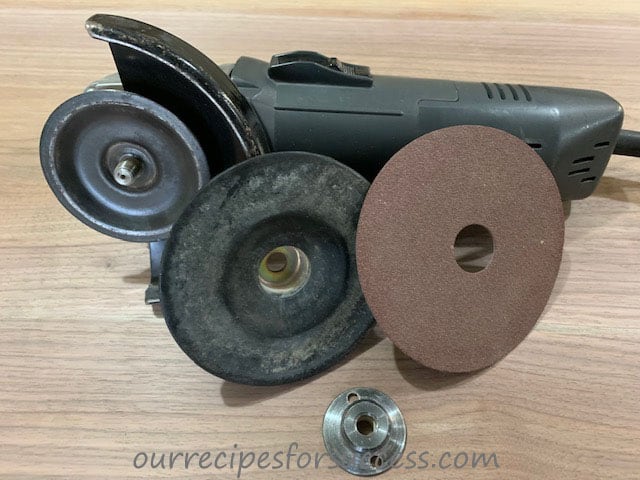
The flapper disc comes in multiple grits and is good for smoothing surfaces. It can be used on metal too. As mentioned earlier, this type of abrasive wheel is more aggressive than a wire wheel, so use it with care on thinner metals.
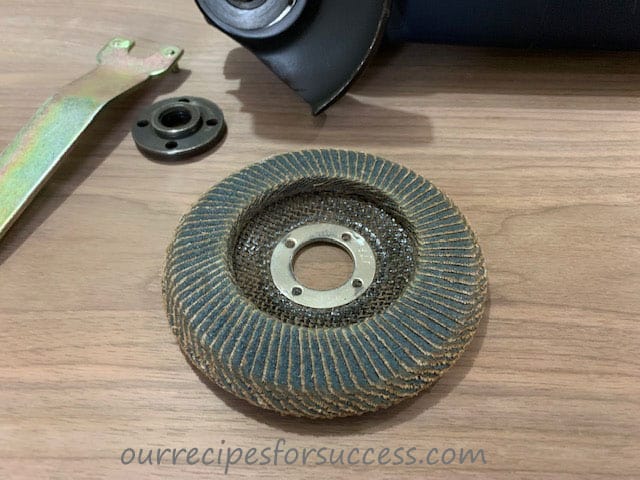
Angle Grinder Uses For Masonry
After metalwork, I think I’ve used my angle grinder on masonry products more than I have on wood. That may be surprising to you, but fitted with the right blade the angle grinder becomes a very useful tool.
Masonry Cutting Blade
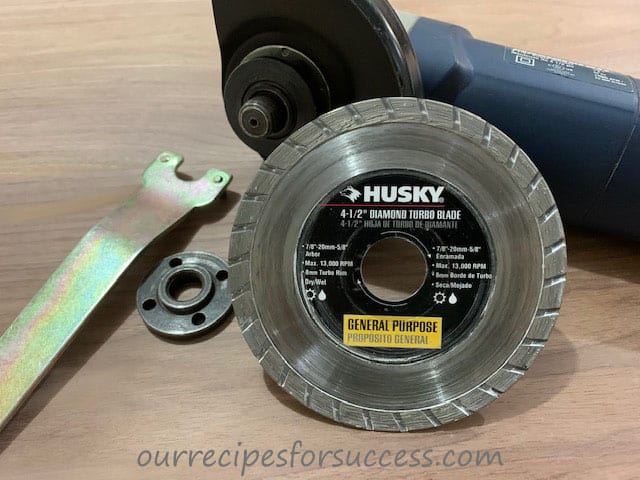
Installing a diamond blade on your angle grinder turns it into a cement eating machine. I have used my angle grinder with a diamond blade for cutting and shaping ceramic tiles, concrete, bricks, landscaping blocks, and pavers.
There are a couple of examples of this work in our article on installing masonry veneer products. My angle grinder with the diamond blade was instrumental in making all the small, intricate cuts. It’s a must-have for these types of projects.
Masonry Grinding Wheel
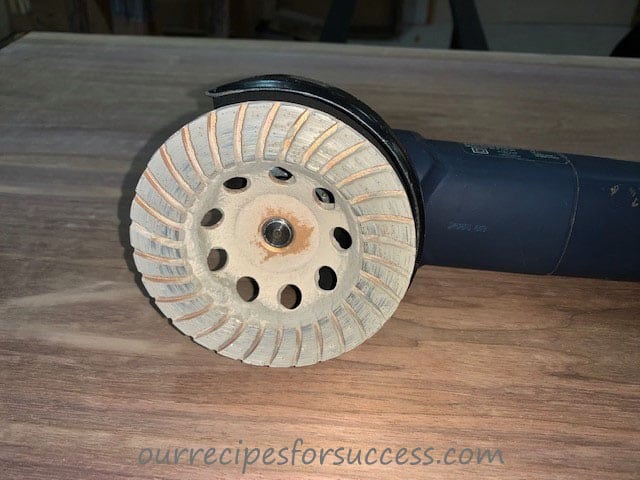
They also make a diamond cup wheel that is good for rough smoothing of cement surfaces. We used one to smooth an outdoor concrete countertop we made, which we hope to share in the future with our readers. It worked very well. For a smooth finished product, you will need to follow up with a polisher.
Masonry wheels can generate a lot of dust so be sure to make your cuts in a well-ventilated area and be sure to wear a good quality dust mask or a respirator. You can use a little water with these wheels to keep the dust down and to help cool them while in use. Be sure to use a GFCI outlet for safety anytime you use water.
Conclusion
As you can see, the number of angle grinder uses is incredible. With the proper blade, these handy tools can cut, trim, grind, or sand almost any material out there. However, angle grinder safety precautions are very important. By using the proper safety gear and using a few good work practices, they are a great tool for almost any project you’ll tackle. So the next time you’re faced with a unique cutting task on a project, don’t forget about your angle grinder.
If you have any comments or questions, you can leave them in the comments section below or you can email us at [email protected]. FYI, we do not collect or share email addresses. We will only use them to reply to your comments or provide answers to your questions. We are also required to let you know that some of our links are “affiliate links”. This means if you click on a link and make a purchase, we could make a small commission, at no extra cost to you. This helps offset the cost of maintaining our website. So, if you like what you’ve seen, please be sure to give us a “Like” and “Share” on Facebook and Instagram too. Thank you for reading and good luck with all your home projects!

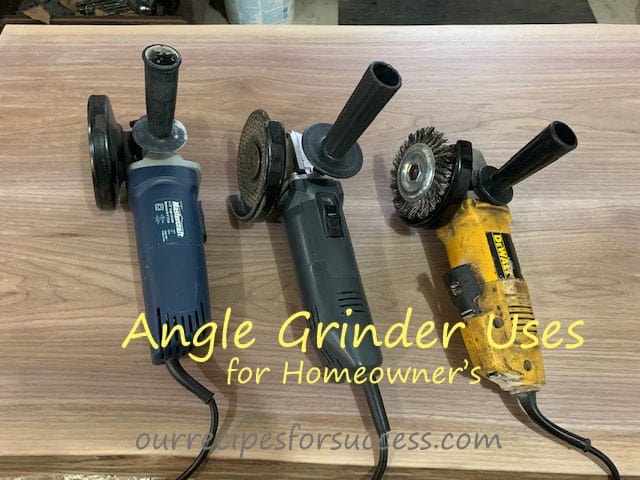


Maybe I should have said water and electricity don’t mix well from a safety standpoint. The point is to make sure anytime someone uses any electric hand tool or appliance in a wet location, safety precautions should be taken. GFCI outlets or devices are among the most effective. Thank you for your comments and for helping to get the right message out to everyone.
I need to correct you on one thing, “water and electricity don’t work well together”
This isn’t true, they work very well together…..too well actually.